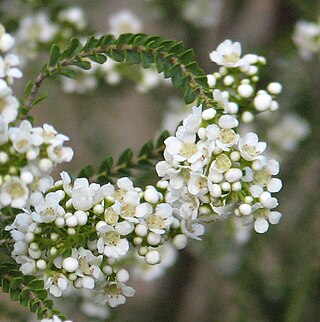
Leucopogon parviflorus, commonly known as coast beard-heath or native currant, is a shrub or small tree in the family Ericaceae. It is native to all Australian states and territories excluding the Northern Territory and the ACT and also grows in New Zealand. The species can grow to between 1 and 5 metres in height and has leaves that are 11 to 29 mm long and 2.4 to 7.5 mm in width, often with curved tips. The white flowers are around 15 mm long and are produced in spikes of 7 to 13. These occur throughout the year.

Grevillea parviflora, commonly known as small-flower grevillea, is a species of flowering plant in the family Proteaceae and is endemic to the Sydney region of eastern New South Wales. It is a low, dense, spreading to erect shrub with more or less linear leaves and white flowers with a red style that sometimes turns red as it ages.

Scholtzia oligandra, commonly known as pink scholtzia, is a shrub species in the family Myrtaceae. It grows to between 1 and 3 metres high and produces white or pink flowers between July and October in the species' native range. The species, which is endemic to Western Australia, was first formally described in 1867 by English botanist George Bentham in Flora Australiensis based on plant material collected by James Drummond on the Murchison River.

Hakea falcata, commonly known as sickle hakea, is a shrub in the family Proteaceae and is endemic to southern Western Australia. It has narrow egg-shaped leaves, cream flowers and blooms in spring.

Hakea linearis is a shrub or tree in the family Proteaceae and is endemic to Western Australia. It has smooth branches, mostly linear leaves and white flowers.
Scholtzia ciliata is a shrub species in the family Myrtaceae that is endemic to Western Australia.

Scholtzia involucrata, commonly known as spiked scholtzia, is a shrub species in the family Myrtaceae that is endemic to Western Australia.

Scholtzia laxiflora is a shrub species in the family Myrtaceae that is endemic to Western Australia.
Scholtzia leptantha is a shrub species in the family Myrtaceae that is endemic to Western Australia.
Scholtzia spatulata is a shrub species in the family Myrtaceae that is endemic to Western Australia.
Scholtzia teretifolia is a shrub species in the family Myrtaceae that is endemic to Western Australia.
Scholtzia uberiflora is a shrub species in the family Myrtaceae that is endemic to Western Australia.
Scholtzia umbellifera is a shrub species in the family Myrtaceae that is endemic to Western Australia.
Thryptomene decussata is a species of flowering plant in the family Myrtaceae and is endemic to Western Australia. It is an erect shrub with upward pointing, egg-shaped leaves, and white or pink flowers with five petals and twenty to thirty stamens in two whorls.

Thryptomene denticulata is a shrub species in the family Myrtaceae that is endemic to Western Australia.

Boronia parviflora, commonly known as the swamp boronia, small boronia, tiny boronia, or small-flowered boronia, is a plant in the citrus family Rutaceae and is endemic south-eastern Australia. It is a weak, low shrub with elliptic to egg-shaped leaves with finely toothed edges and up to three pink, white or green four-petalled flowers arranged at or near the ends of the stems.

Acronychia parviflora is a species of shrub or small rainforest tree that is endemic to north-eastern Queensland. It has simple, egg-shaped to elliptical leaves, flowers arranged singly or in small groups in leaf axils and fleshy, more or less spherical fruit.

Pultenaea parviflora, commonly known as Sydney bush-pea, is a species of flowering plant in the family Fabaceae and is endemic to eastern New South Wales. It is usually a small, erect shrub with wedge-shaped to narrow egg-shaped leaves with the narrower end towards the base, and clusters of yellow to orange and red flowers.
Commersonia parviflora, commonly known as small flowered rulingia, is a species of flowering plant in the family Malvaceae and is endemic to the south of Western Australia. It is a low, prostrate or dense shrub with wrinkled, egg-shaped leaves with rounded teeth on the edges, and clusters of small, white flowers.
Acrotriche parviflora is a species of flowering plant in the family Ericaceae and is endemic to the south of Western Australia. It is an erect, spreading or compact shrub, with oblong to narrowly egg-shaped leaves, and green, tube-shaped flowers.











